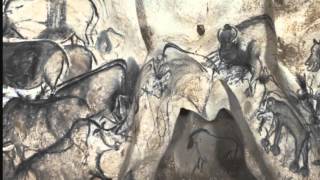By March of the Titans
The Chauvet-Pont-d’Arc Cave in the Ardèche department of southern France is a cave that contains some of the earliest known cave paintings, as well as other evidence of Upper Paleolithic life. It is located near the commune of Vallon-Pont-d’Arc on a limestone cliff above the former bed of the Ardèche River, in the Gorges de l’Ardèche. Discovered on December 18, 1994, it is considered one of the most significant prehistoric art sites.
The cave was first explored by a group of three speleologists: Eliette Brunel-Deschamps, Christian Hillaire, and Jean-Marie Chauvet for whom it was named. Chauvet (1996) has a detailed account of the discovery. In addition to the paintings and other human evidence, they also discovered fossilized remains, prints, and markings from a variety of animals, some of which are now extinct. Further study by French archaeologist Jean Clottes has revealed much about the site. The dates have been a matter of dispute but a study published in 2012 supports placing the art in the Aurignacian period, approximately 30,000–32,000 BP.
The cave is situated above the previous course of the Ardèche River before the Pont d’Arc opened up. The gorges of the Ardèche region are the site of numerous caves, many of them having some geological or archaeological importance. The Chauvet Cave is uncharacteristically large and the quality, quantity, and condition of the artwork found on its walls have been called spectacular. Based on radiocarbon dating, the cave appears to have been used by humans during two distinct periods: the Aurignacian and the Gravettian. Most of the artwork dates to the earlier, Aurignacian, era (30,000 to 32,000 years ago). The later Gravettian occupation, which occurred 25,000 to 27,000 years ago, left little but a child’s footprints, the charred remains of ancient hearths, and carbon smoke stains from torches that lit the caves. After the child’s visit to the cave, evidence suggests that due to a landslide which covered its historical entrance, the cave had been untouched until it was discovered in 1994. The footprints may be the oldest human footprints that can be dated accurately.
The soft, clay-like floor of the cave retains the paw prints of cave bears along with large, rounded, depressions that are believed to be the “nests” where the bears slept.
Hundreds of animal paintings have been catalogued, depicting at least 13 different species, including some rarely or never found in other ice age paintings. Rather than depicting only the familiar herbivores that predominate in Paleolithic cave art, i.e. horses, cattle, mammoths, etc., the walls of the Chauvet Cave feature many predatory animals, e.g., cave lions, panthers, bears, and cave hyenas.
Typical of most cave art, there are no paintings of complete human figures, although there is one partial “Venus” figure composed of a vulva attached to an incomplete pair of legs. Above the Venus, and in contact with it, is a bison head, which has led some to describe the composite drawing as a Minotaur. There are a few panels of red ochre hand prints and hand stencils made by spitting pigment over hands pressed against the cave surface. Abstract markings—lines and dots—are found throughout the cave. There are also two unidentifiable images that have a vaguely butterfly or avian shape to them. This combination of subjects has led some students of prehistoric art and cultures to believe that there was a ritual, shamanic, or magical aspect to these paintings.
The artists who produced these unique paintings used techniques rarely found in other cave art. Many of the paintings appear to have been made only after the walls were scraped clear of debris and concretions, leaving a smoother and noticeably lighter area upon which the artists worked. Similarly, a three-dimensional quality and the suggestion of movement are achieved by incising or etching around the outlines of certain figures. The art is also exceptional for its time for including “scenes”, e.g., animals interacting with each other; a pair of woolly rhinoceroses, for example, are seen butting horns in an apparent contest for territory or mating rights.
Dating
The cave contains some of the oldest known cave paintings, based on radiocarbon dating of “black from drawings, from torch marks and from the floors”, according to Jean Clottes. Clottes concludes that the “dates fall into two groups, one centered around 27,000–26,000 BP and the other around 32,000–30,000 BP.” As of 1999, the dates of 31 samples from the cave had been reported. The earliest, sample Gifa 99776 from “zone 10”, dates to 32,900 ± 490 BP.
Source Article from http://www.renegadetribune.com/prehistoric-europe-birthplace-art/
Related posts:
Views: 0
 RSS Feed
RSS Feed

















 June 5th, 2017
June 5th, 2017  Awake Goy
Awake Goy 




 Posted in
Posted in  Tags:
Tags: 
















